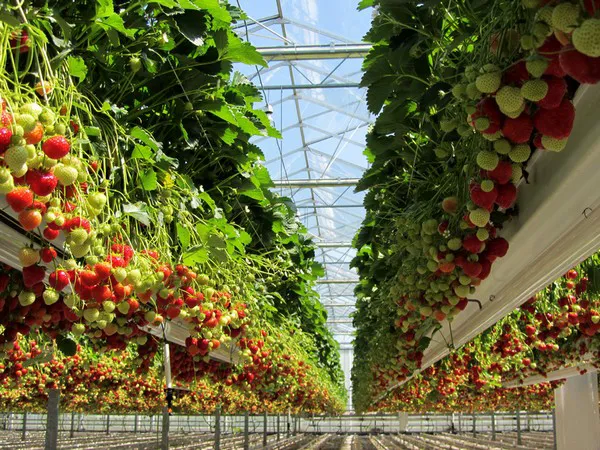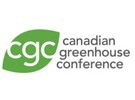During the Canadian greenhouse conference in early October, multiple sessions were organized on both days to discuss various topics in the greenhouse industry. On Thursday afternoon, the strawberry production session focused on key aspects of greenhouse strawberry production, namely lighting, substrate selection, diseases affecting strawberries, and flower mapping. Below is a summary of each presentation.
Learning from the field: strawberry disease management
Katie Goldenhar of the OMAFRA gave a presentation on the diseases affecting field strawberries, which may eventually find their way into greenhouses. The first of these was anthracnose fruit rot, which is a fungal pathogen that produces distinct brown/black lesions on the fruit. This is especially problematic for day-neutral varieties grown outdoors, as fruit is being produced during hot, humid months. Anthracnose is a very aggressive fungus that requires a combination of treatments, such as removing the infected berries practicing crop rotations selecting resistant varieties, and the use of certain chemicals.

Tatjana Kraminkina | Dreamstime.com
Katie also discussed a fungal pathogen that has emerged in recent years, having first been reported in Florida strawberry fields in 2017. Neopestalotiopsis is an aggressive fungus that causes crown rot, leaf lesions, and fruit rot. The fungus produces a black coating on the fruit when sporulating. There are currently limited or no control measures available in a field, with long-term control expected to come from cultivar development. In autumn 2020, Neopestalotiopsis symptoms were seen a single location in Ontario on the crowns and foliage of Albion plants. The fungus has also been reported in New Jersey, North Carolina, and Georgia.
From transplanting to harvest: getting the most from your strawberry crop with dynamic light
Rose Seguin of Sollum Technologies presented best practices in strawberry lighting and highlighted the various lighting strategies targeting trayplant production, early stretching of stems, improvement of Brix levels, and the potential for light-mediated passage and control.
With respect to trayplant production, Rose's presentation highlighted how growers can use supplemental lighting to produce their own trayplants for both greenhouse and field production. Furthermore, the research presented highlighted how the optimal lighting conditions can vary between strawberry cultivars, making it beneficial for growers to be able to adjust their lighting systems accordingly. The presentation also highlighted how certain spectrums can be applied depending on the time of year and the ambient light conditions to produce the ideal plant and improve fruit quality.
Getting off the ground: growing strawberries in substrates
Shawn Mallen of A.M.A Horticulture, also the company sponsor of the session, then took the microphone to talk about the selection of substrates for growing greenhouse strawberries. As Shawn explains, A.M.A Horticulture's strategy is to adapt the media to the grower, not the other way around. There is no one-size-fits-all solution to substrate selection, as it all depends on the grower's comfort with specific media formulations.
Although the ideal substrate for strawberry production is grower-specific, Shawn mentioned that a baseline mixture for greenhouse strawberries would be the BC5 mix which is 40% coco, 40% peat, and 20% perlite. The peat fraction is subdivided according to particle size, which is strongly related to where the peat was harvested. For example, European peat is more complex as it is harvested to a lower depth, whereas North American peat is harvested closer to the surface and has a finer grade. With respect to coco, Shawn highlighted that it is important to make sure that it is all washed, buffered, and meets the RHP requirements.
Strawberry flower mapping
The last presentation was given virtually by Edward Durner of Rutgers school of environmental and Biological Sciences. The presentation focused on flower mapping, which is a method of describing flower development by counting strawberry flowers and identifying the developmental stages of flower buds. Flower mapping can be used to determine the flowering potential and, thus the economic potential of strawberry plants.
This method is more easily explained by Edward himself, and he was kind enough to provide links to videos explaining flower mapping and how it can benefit strawberry growers.
Strawberry Flowering Physiology
Setting up and installing your Plugable Digital Microscope
Flower Mapping A Strawberry Plug Plant
Edward also spoke about an interesting project called "Empowering Northeastern Strawberry Growers with Flower Mapping." The aim of this project is to teach strawberry growers how to conduct flower mapping on their own and use flower mapping as a management tool to replace calendar-based recommendations for nitrogen fertilization. Any growers interested in participating in the project are encouraged to reach out to Edward at [email protected].
Overall, the strawberry session provided insights into many key elements of strawberry production. Most, if not all, of the presentations, will be posted on the conference website in the coming weeks.
For more information about the presentations: 
Canadian Greenhouse Conference
[email protected] www.canadiangreenhouseconference.com
